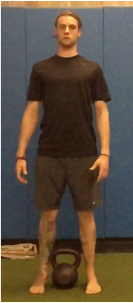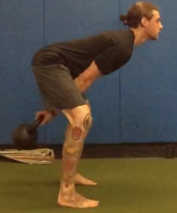The Set Up
Setting up for a kettlebell swing should resemble the set up for a deadlift. Feet should be positioned about shoulder width apart, spine should be neutral, and shoulders should be externally rotated for proper posture.
While maintaining a neutral spine drive your hips back to engage the hamstrings. Bend over at your hips while maintaining a flat back and keeping the shoulders engaged.
Just like in a squat, your shins should remain vertical as you reach end-range. When grabbing the kettlebell it is important to set the shoulders in the right position by creating torque through external rotation. The best way to do this is to imagine the handle of the kettlebell is a bundle of pencils you are trying to snap in half. To maintain good position as you rise up, continue to drive your knees outward and raise your hips.
The Swing
Deallift the kettlebell off the ground and return to a standing position. In order to reset your body into a neutral and braced position extend your hips by squeezing your butt. Continue to pull your shoulders back by trying to “break” the kettlebell, and create tension through the lower body by screwing your feet into the ground, just as you would for a squat or deadlift.
Initiate the Kettlebell swing by simultaneously sitting your butt back, driving your knees outward, and hinging forward through the hips.
To power through the rest of the swing drive your hips forward into your forearms. While keeping your arms tight to your body, explosively extend the hips. Do this properly by keeping your weight evenly disbursed over the center of your feet while extending the knees, hips, and fully squeezing your glutes all at the same time.
At the top of each swing you should experience a moment of weightlessness. At this point it is important to reset the hips and spine into a neutral position by squeezing your glutes and driving your shoulders back.
Common Faults
Shoulder Fault
Shoulder Faults
Poor posture and failure to set up the swing properly will commonly lead to the shoulders defaulting to an internally rotated position.
Mobility correctives:
- Soft tissue work on the anterior and posterior shoulder, specifically around the border of the scapular and underneath the clavicle.
- Manipulate your grip by grabbing the outside of the kettlebell handle. This gives you some leeway if you perform this fault, but remember this is not normal. You must address mobility issues so you can avoid scaling movements.
Head Faults
Head Fault 1
This is a common fault that typically occurs for one of two reasons:
An athlete sets up for the swing correctly but attempts to fight the downward momentum of the swing by throwing his head back to avoid falling forward.
Head Fault 2
Coaches will often use a cue such as “head up” when having someone perform the swing. The coach may either be unsure of how the movement should be done correctly or may be using this cue in an attempt to correct someone’s downward head fault. Either way this miscommunication will often lead to one of these head faults.
The key for fixing either of these scenarios is to have the athlete keep his head neutral and watch the ground about five or six feet in front of him. This allows the eyes to stay on a fixed area while the head continues to move with the rest of the body and maintain a neutral spine.
Hip Faults
The hip fault tends to occur in people who have a weak lower back, are either unable to or fail to generate tension throughout their body, or are fatigued towards the end of a set. As you can see, this fault looks as if I’m trying to chase the kettlebell underneath my body with my torso. This fault can be avoided by properly setting up for each set of swings, taking advantage of that moment of weightlessness at the top of each swing (mentioned earlier) to reset the hips, and remembering to start and finish each and every movement with good position.
Hip Fault


















